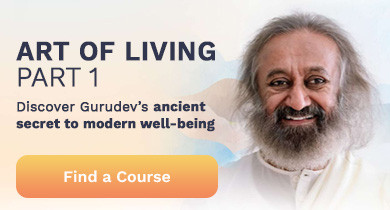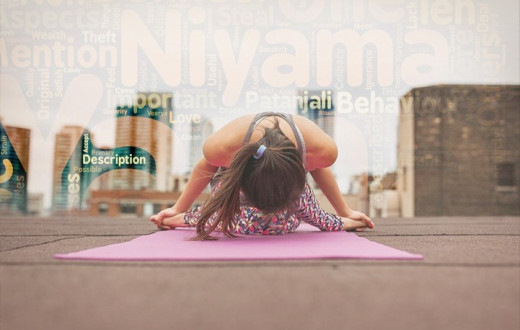By Sejal Shah I Updated: July 28, 2020
This is part one of a series exploring each of the Yamas and Niyamas to discover how we can integrate them into our daily life experiences - both on and off the mat - for a deeper, richer and fulfilling life.
What is Ahimsa?
Ahimsa is a Sanskrit word meaning "non-violence." The term is derived from the root word himsa, meaning "to cause pain," and the prefix - ‘a’ means "not." Himsa (physical violence) arises out of fear, and fear leads to insecurity, which causes us to feel separate from others—alone and misunderstood.
Ahimsa , the first and foremost of the five yamas (restraints) of the great sage Patanjali's eightfold path as described in the Yoga Sutras, enables us to live in such a way that we cause no harm in thought, speech, or action to any living being, including ourselves. In its purest form, ahimsa is the spontaneous expression of the highest form of love — universal love, kindness, compassion and forgiveness — an unconditional sense of belonging to everyone and everything.
“Already without your knowledge you are destroying many creatures. You walk and many ants are dying under your feet. You are not killing anyone. It is just happening. But an intention to destroy something, an intention to do violence can destroy your very basis, your very own root. Dropping this intention for violence is ahimsa.” - Gurudev Sri Sri Ravi Shankar
Ahimsa is not a passive force; it is possible to radiate non-violent energy actively, bringing peace to others. Examples include vegetarianism (adopting a vegan or vegetarian lifestyle) or, in our modern age, living in a way that does not harm the environment, or any living creature, not harming ourselves including no physical harm as well as emotional harm to ourselves with the likes of destructive habits, negative thoughts and repressed emotions, criticising others, or pushing ourselves too far in a Yoga pose. Find out 10 ways of practising ahimsa here.
Taking Inspirations from the Warriors of Ahimsa
Besides Sage Patanjali, the concept of ahimsa was spoken of in India by Lord Mahavira—propounder of Jain dharma (599-527 B.C.E.), Gautama Buddha (566-486 B.C.E.) and in China by Lao Tzu (sixth century B.C.E.). The doctrine of compassion was also taught by Jesus Christ ("Love your neighbor as yourself" or "Thou shalt not kill.") and the Apostles. The essential doctrine of ahimsa has also been demonstrated by many philosophers, political activists, scholars, scientists and religious leaders, including Henry David Thoreau, Sojourner Truth, Thomas Merton, M.K. Gandhi, Sir Bertrand Russell, Dorothy Day, Mother Theresa, Martin Luther King, Jr., The Dalai Lama, Robert Thurman, Peace Pilgrim, Rev. Matthew Fox, Nelson Mandela, Mother Teresa, to name a few. These warriors of ahimsa teach us that conflict is inevitable in our human world, but that we can bring love and compassion amidst conflicts to resolve them and make a positive impact in the world. Whether it is Hinduism or Jainism or Christianity, or any other cultural or religious tradition, the practice of ahimsa has been fundamentally recommended by one and all.
In today’s world, where we are so often threatened and shocked by violent incidents like mass shootings, adhering to ahimsa may seem unrealistic. But if you honestly look inwards with a calm mind, the truth of the power of ahimsa will seem so practical. India winning her independence battle with the non-violent freedom movement led by Mahatma Gandhi may seem like the distant past, but the recent story of peaceful reconciliation inspired by Gurudev Sri Sri Ravi Shankar between the Columbian government and FARC guerrillas in June 2015, that became instrumental in ending the brutal 52-year war that has left 225,000 dead and another 7 million displaced will definitely inspire us to pursue ahimsa (nonviolent resistance) as a way for conflict resolution.
Benefits of practicing ahimsa:
The yogis of the past practiced ahimsa as part of their spiritual development. Practicing ahimsa takes courage and skill and challenges us on both a physical and mental level. Refraining from thoughts and words that can cause pain to others and refraining from retaliating when insulted or unjustly criticized are some examples of ahimsa. “Ahimsa pratishtayam tat sannidhau vairatyagaha’’ (Yoga Sutra II. 35)
Maharishi Patanjali explains that if you are established in non-violence, in your very presence, violence and hostilities or aggression will be dropped by others (Yoga Sutra 2.35).
When ahimsa is mastered, one attains the siddhi (power) of peacefulness, and whoever is in the presence of such a person feels peaceful. For example, if someone wants to confront you, as soon as they come near you, because your vibrations are totally peaceful, they drop down their own violence too. Your peacefulness and non-violence inspires others to be non-violent in your presence. This is so empowering. Imagine, if 50% of the world population starts practicing ahimsa, the rest of the 50% will automatically become non-violent!
Besides this highest benefit, at a personal level, practicing ahimsa -
Exudes vibrations of love and peace
Increases willpower and acceptance
Generates mental fortitude
Cultivates courage and confidence
Helps to overcome anger, fears and insecurities
Expands our sense of belonging
Improves our relationships with the self and with others
Increases assertiveness, patience and communication
Reduces stress and helps to achieve peace of mind
In short, practicing ahimsa (non-violence) helps us create a positive, peaceful, and harmonious world for ourselves and others.
Regular practice of yoga (asana, pranayama, and meditation) can help to develop this attitude of non-harming. Yoga calms the mind, increases self-awareness, and helps one to recognize the supreme expression of Self. Meditation brings that inner peace which in turn establishes non-violence. The practice of non-violence is a two way traffic. Ahimsa brings about the union of the mind, peace of mind, and when you are peaceful or calm within, you naturally become non-violent.
Practicing ahimsa requires skill
One of the great yoga philosophy scriptures ‘Bhagwad Gita’ says - “yogah karmasu kaushalam” - meaning yoga is skill in action.
One of the challenges, if not confusions, that often happens with practicing ahimsa (non-harming) in parallel with rest of the yamas and niyamas, is how to balance them. To make this balance work, we can consider that ahimsa is the central practice of the five yamas, and that the other four yamas (and niyamas) are in support of that.
Learning how to delicately balance truthfulness while not being painfully honest with others is a real art of yoga. Think of the many situations in life when your so-called truthfulness could cause pain to others, including simple examples, such as your comments about a meal served at a friend's home or what you might say if someone asked you about their physical appearance or clothes when dressed for some special occasions.
If your mind is not in the moment and quiet enough to artfully maneuver around such a situation, which would you choose, to be painfully honest or mindfully honest for the sake of not hurting the other person? Sure, we'd like to be proficient enough to practice both non-harming (harmlessness) and non-lying in perfect balance, but until we master this skill, we need to be ever mindful of the most important practice, which is to first and foremost to cause no harm. The same method can be applied to practicing the rest of the other Yamas and Niyamas. One by one, we can get mastery over each and this will ultimately lead to mastery over all of them in letter and spirit.
Find out how we can practice ahimsa: 10 Immediate Ways to Practice Non-Violence in Your Daily Life
Sign up for Beyond Breath - a free online session on Breath and Meditation and take a first step towards self care and ahimsa today!
Sejal Shah, E-RYT 500 Sri Sri Yoga Teacher, YACEP, C-IAYT, Meditation Teacher, Happiness expert, NYU Post Graduate Medical School approved Yoga-CME retreat facilitator, Mind-Body Wellness Writer, Homeopath. She can be followed on Instagram, Twitter, and Facebook.





























